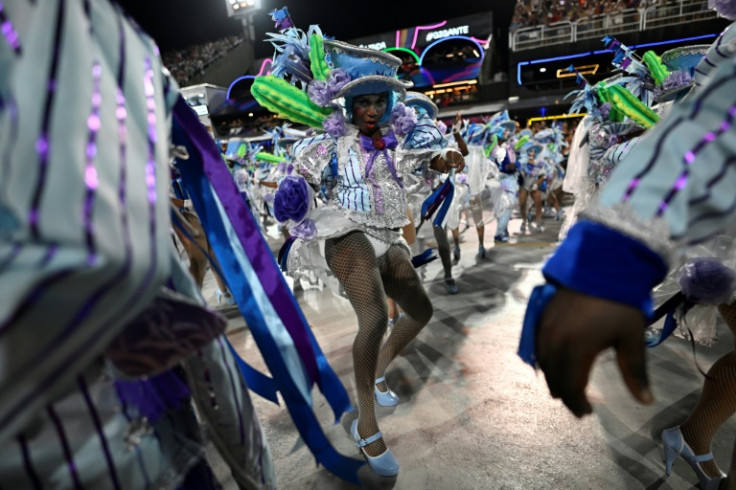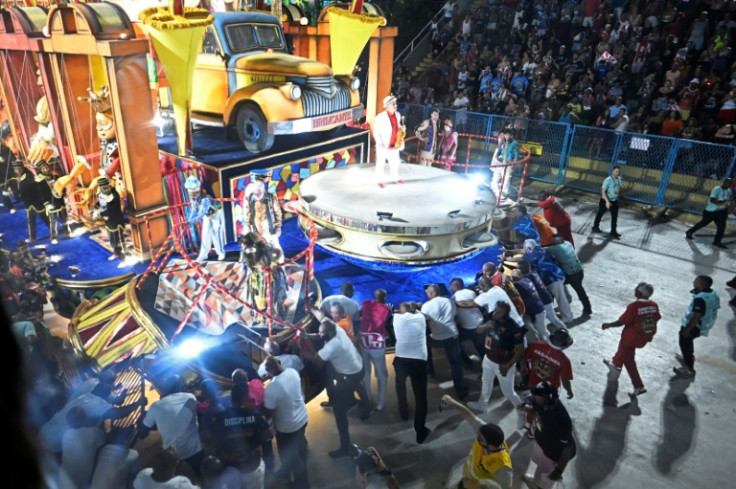'Everyone Jumping, Everyone Happy': Rio Celebrates Carnival

Glittering with sequins and sweat, thousands of performers shimmying to sultry samba beats danced their way down an avenue in Rio de Janeiro Sunday as the Brazilian beach city's famed carnival parades got under way.
With whimsical floats, thundering drum sections and legions of performers in fanciful, flesh-flaunting costumes, 12 samba schools are competing for the coveted title of carnival champions across two nights of epic booty-shaking.
Porto da Pedra, a school from the impoverished Sao Goncalo neighborhood, opened the festivities with a float topped by an enormous, roaring orange tiger that swatted out at the crowd with its claws, drawing shrieks of delight.
Entering the parade venue "gives me goosebumps every time," said Debora Moraes de Souza, a 53-year-old doctor who grew up in Sao Goncalo and has been parading with the school for a decade.
"You get to the end and you say, 'Oh, it's over already? I want more!' Everyone's jumping, everyone's happy.'"
Rio has already been celebrating carnival for weeks with colorful, free-for-all street parties known as "blocos."
The parades are the climax: sumptuous festivals of color and sound that last all night and into the next day.
Flying the colors of their favorite schools, a capacity crowd of 70,000 spectators cheered from the packed stands of the Sambadrome stadium, the city's purpose-built parade venue, with millions more expected to watch live on TV.
But there is more to carnival than all-night partying.
The samba schools are rooted in Rio's impoverished favela neighborhoods, and each parade tells a story, often dealing with politics, social issues and history.
This year's parades include homages to little-known heroes of Afro-Brazilian history and a celebration of the Yanomami Indigenous people, who have been ravaged by a humanitarian crisis blamed on illegal gold mining in the Amazon rainforest.
Pulling together a show with more than 3,000 performers and a fleet of seemingly gravity-defying floats is no easy feat.
The samba schools spend the entire year preparing -- and often face a down-to-the-wire race to get ready.
"It's always a last-minute rush to get everything looking great," said Priscilla Frota, a 42-year-old restaurant owner, as she adjusted a barely-there costume before strutting her stuff atop a float for Beija-Flor.
"We climb on the float to test out our spots, so we don't get scared of the height and get vertigo. We try on our costumes, make sure everything fits, that nothing's missing."
Marina Oliveira, 35, was taking a selfie in front of a float she helped create for the Salgueiro samba school.
"It has feminine strength -- it was made entirely by women," she told AFP, admitting that she was "very nervous" to parade for the first time.
Alexandre Reis, a 52-year-old electrical technician, was heading up a team rushing to fix a last-minute problem: the light on one side of their float weren't working.
Reis has been on hand to handle just such emergencies for the past 23 years.
"It's a very complex job. The lighting demands a lot of technical expertise, because (the floats) are like a moving, open-air stage," he said.
But "I do this from the heart," he added. "We sweat and bleed because we love the school."
The parades were particularly political under far-right ex-president Jair Bolsonaro, who faced accusations of authoritarianism, racism, environmental destruction and disastrous mishandling of Covid-19 -- all fodder for the samba schools during his 2019-2022 presidency.
The overall tone is less politically charged since veteran leftist Luiz Inacio Lula da Silva returned to the presidency in January 2023.
Invented a century ago by the descendants of African slaves, samba is one of the great symbols of Brazilian popular culture, and of Rio.
Each samba school has 60 to 70 minutes to dazzle its way down the 700 meters (yards) of the Marques de Sapucai, the avenue through the concrete carnival parade temple designed by modernist architect Oscar Niemeyer.
Carnival is also big business for Rio: the party is expected to generate 5.3 billion reais (more than $1 billion) in revenues this year.




© Copyright AFP 2025. All rights reserved.





















